Incubator
This page mostly focused on placing unhatched eggs from a turkey nest into the incubator. On occasions, a raccoon or fox will kill the hen and we have to incubate the eggs for the full 28 days (turkey time")
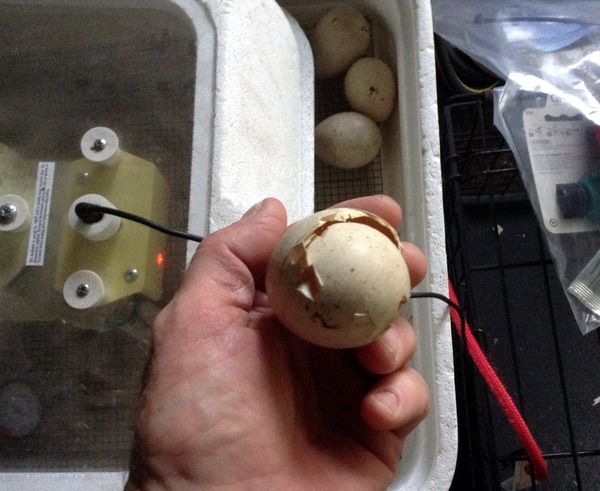
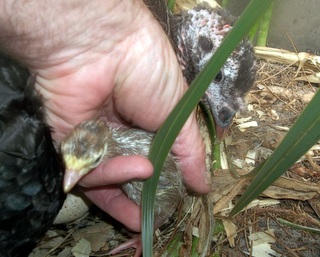
Healthy pout! But what about the "unhatched" eggs?
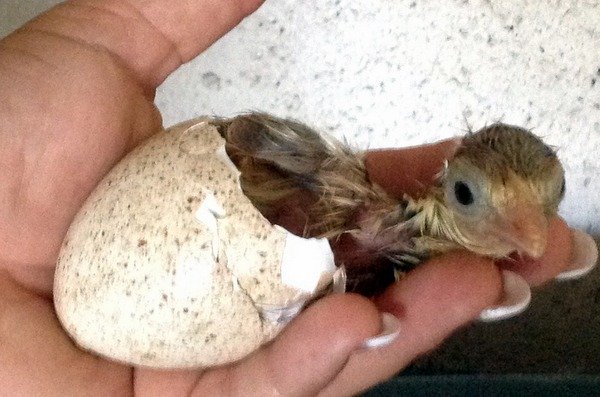
Incubator success!
The incubator can be used several ways. Recently I had an opossum raid a nest during the night and destroy 7 of 14 eggs. I set a box trap to catch the opossum; however until the raider was captured, I placed the 7 remaining eggs in a pre-warmed incubator and gave the turkey hen two ceramic “fake” eggs to sit on.
As soon as I caught the opossum (it took two nights) I returned the 7 real eggs to the hen and retrieved the fake eggs.
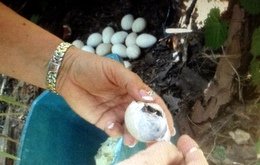
This egg accidently crushed by its' mother was peeled open
and the poult placed in the incubator until dry-then back to mom.
Turkey injuries and the incubator:
While searching for the hidden nest of one of our eastern wild hens - I found another hen nesting on the fence line near my garden. What tipped me off was the "feathers strewn about" (indication of a fight) then I spied the hen and a fair amount of broken eggs scattered around her. The hen was still on the nest; I did a quick check and observed she had five eggs remaining.
When the hen came off for a dust bath, I switched the eggs. Two fake eggs in the turkey nest and this time I placed the five eggs under our broody seabright chicken instead of the incubator. Note: little the seabright is only temporary because the incubator is suddenly crowded. I don’t think the seabright, -a very small chicken can rotate the turkey eggs as needed.
Oddly enough --and it is rare: the turkey hen who evidently fought a losing nocturnal battle to defend her eggs did not return to her nest and after a few days I took the eggs from the seabright and placed the eggs in the incubator.
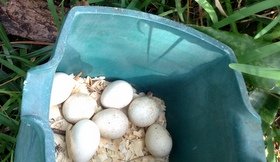
Eggs on the way to a pre heated incubator
Why is my incubator suddenly crowded in only one Saturday? Two nesting hens had poults hatch out yesterday! Both nests hatched early, I suppose because of the early heat we are having in Florida (or I simply counted wrong)
However in each nest only 3-4 babies hatched out. Rather than risking a night raider (Raccoon or Opossum raids have suddenly peaked) I moved each hen and her brand new poults to inside secure and dry pens. The remaining eggs I placed in the incubator. One egg is tapping, the others are silent. Yet I expect the eggs to hatch out in a few days and I will split the poults between the two hens. (Ensuring each hen has a mixture of colored poults)
After about a week I will let the two hens meet and become dual parents to a combined flock of little ones.
Interesting link from a commercial poultry site in Australia with suggestions on hatching problems, humidity and egg rotation: http://www.poultryhub.org/physiology/incubation/
And now: incubator musings……
**Hygiene!!!
Wash your hands every time:
*After you assist a baby turkey to escape from egg
*You handle newly hatched turkeys or other birds (transfer poults to a brooder or hen)
*Open and close the incubator to add water, clean or rotate the eggs
*Sanitize the incubator
Cleanliness & the incubator!
Don’t forget- a clean incubator is a healthy incubator! As the baby turkeys chip their way free of the egg, they will drop broken shell into the incubator water (added for humidity). After the escape from the egg, other items will drop into the heated water: various body fluids (yolk, blood & things from inside the egg that I have no name for). Consequently after the eggs hatching you will have created you own primordial egg drop soup complete with harmful bacteria.
Please clean!
The fertile eggs will not suffer if you set them aside for twenty minutes while you scrub the incubator, screen & replace the water. Heritage turkey hens have to leave the nest once or twice a day to drink and void wastes. So the short time outside of the incubator while you clean will not harm your future turkeys. (Ensure the replacement water is hot!)
By the way, if you have a power outage or your incubator dies and you have to get an emergency replacement: The eggs should be fine for the same reason as mentioned above.
Don’t forget: wash your hands afterward cleaning the incubator!
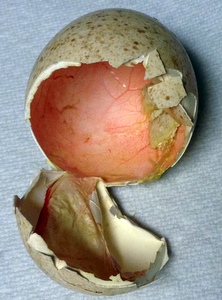
Don’t forget: wash your hands!
Begin the process……
Pre-Incubation steps
If needed, gather up the eggs you wish to incubate for safe keeping: for example if a raccoon is stealing the eggs at night, you can collect them and store for up to three weeks, however when possible do not store longer than 14 days. Wipe them clean if necessary with a damp paper towel.
If eggs with different due dates are placed in the same incubator, I prefer to mark the eggs with a tiny patch of colored tape. Some people use a pencil to mark the eggs. Note: I always avoid using a sharpie marker. I may be overreacting, but I worry about the effect that sharpie ink may have on a developing pout. Obviously we never store the eggs near chemicals or cleaners. Eggs- the miracle containers of life are actually very porous with thousands of tiny air holes through which the embryo breaths. These very same air holes will allow dangerous chemicals to percolate into the egg and damage the developing poult or chick. I even avoid storing the eggs in plastic bowls (because of off-gassing).
When practicable protect the eggs from extreme fluctuations of heat or cold. During the early spring in Florida, we store the eggs outside in an area safe from predators & only bring them into the house during one of Florida’s rarer cold fronts. I may be overreacting again, as I have witnessed successful hatchings even when the temperature had fallen below 35 degrees before the hens begin sitting.
Pre warm the Incubator
Turn on the Incubator to make sure it works! (We have actually purchased a backup incubator)
A general rule of thumb is to turn it on 24 to 48 hours to get an understanding if the incubator is to hot or cold. Bad idea to adjust the temperature with eggs already inside. Best incubating temperatures are from 97 to 101 degrees. We keep ours approximately at 99 F
In emergencies, we add hot water to“Jump start” the process by adding hot tap water to the water storage area. Occasionally we have a turkey hatch her nest & several eggs are still alive but unhatched, calling for an emergency jump start of the incubator. (A broody chicken hen or even a another nesting turkey will work to keep the eggs warm)
Most modern incubators have a reservoir for water to keep the atmosphere humid. Add warm water as needed to keep the humidity high. During the last week of incubation, high humidly is crucial for the hatching process.
Hatching times
Place the eggs flat in the incubator and mark the calendar for 28 days. Be cognizant that the temperature inside the incubator will temporarily drop when placing cooler eggs inside.
Note: other birds hatching times can be different; the following in an approximate guideline:
Chickens - 21 days
Quail & Pheasant - 21 to 23 days
Turkey - 28 days (during hot spells, seems like 25 days is the prime period)
Geese -28 to 30 days
Ducks -28 to 33 days
Hatching chart of various birds
Note: In a picture below, I note the turkey poult was ten days late. How? Only explanation is another hen stopped by and dropped an egg in the existing nest ten days after the hen began setting. Perhaps while the mother was out dust bathing.
Egg Rotation
Eggs should be rotated 3-4 times a day, much as a mother hen rotates her eggs while sitting on her nest.
*****If the eggs are not rotated, the hatch rate drops to nearly zero!
*****Egg rotation (turkey eggs) should cease around day twenty-second day of the incubation process to allow the bird time to orient itself before beginning the chipping out process
Humidity
When the time comes for the poult to escape, the little bird slowly turns inside the egg shell pecking until it has chipped a circle clear around the large end of the egg and the end cap falls off.
I’m not really sure how long this pecking process takes; but at least two days and on occasion there are problems.
In low humidity conditions the egg fluids will have dehydrated and the poult sticks to the shell unable to spin and peck. When this happens the poult will not be able to escape from the shell and requires the human touch.
Close monitoring of the piping process will give you an warning that the little one is trapped and will require assistance to escape from the egg. Just last week we had to assistance in the escape process. What keys us in to action was the frantic chirping coming from the egg, not the normal happy chirp that begins the bonding process of hen to babe.
Turkey Incubation and Hatching Guide (from Backyard Chicken)
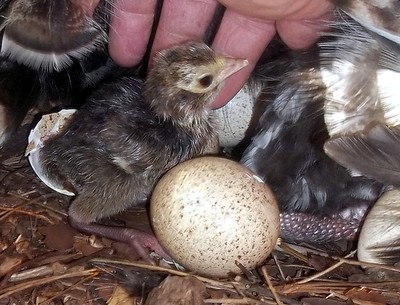
Look closely to see the "Pipped" turkey egg
“TAP--TAP”, well a soft tap, tap—Listen closely and you can hear the tap. Personally I am amazed that the baby bird can chip through the egg. The little ones have no strength, no room for striking; yet the process has worked for, well since before the dinosaurs ruled the planet.
The escape from the egg is assisted by an “egg tooth” –Not an actual tooth, but a small growth developed for the purpose of cutting the egg cap off. The egg tooth is first used to cut through the inner membrane of the eggshell to create an air hole and then the chipping of shell. If you look closely at an egg that is near the 28th day you will see a miniscule outward bulge where the egg tooth is pushing through the shell & soon afterwards the air hole. The egg tooth falls off several days after hatching.
As mentioned already: Egg rotation should cease if you hear the tap tap.
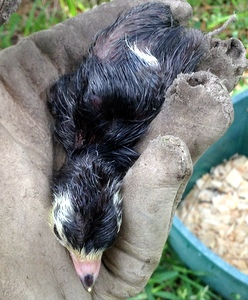
This bird in the above picture was hatched under a hen, but the 'un hatched' eggs will go to the incubator.
Thought this was a good shot of the egg tooth.
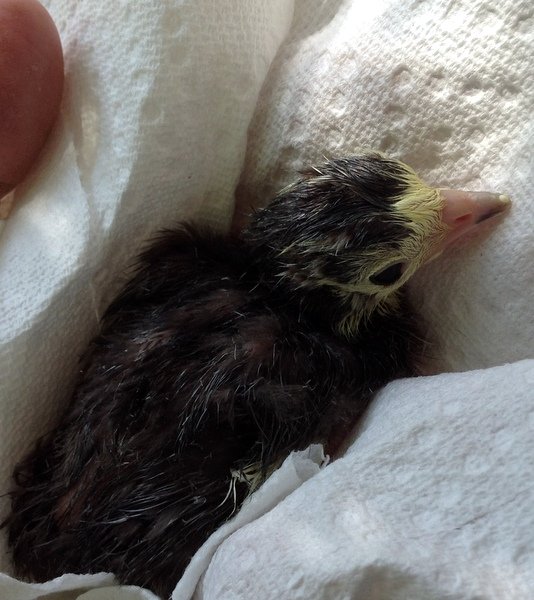
This Spanish Black (or Norfolk Black) just came out the incubator.
10 days late! And another picture of an egg tooth.
I just happen to have another hen with a newly hatched brood that I will slip this baby under.
If the hen was not available I would have to use a brooder box and heat lamp
Rambling final thoughts.....
The hen and poult (or poult and human) will form a nearly unbreakable bond. However during the first few days & with any egg you can mix and match hen and poult with neither mother or babe realizing the switch.
I have had people ask me "Doesn't the mother smell (as in scent) which poult or egg is hers?"
The answer is "no"--- Most birds like humans have a poor sense of smell. (omitting buzzards of course)
The turkey mother-poult attachment is developed from visual, auditory and physical contact cues. (Baby turkeys love to nuzzle)
And the instinct to be social will even override that bond--for example, if you lose your hen to some disaster you can often transfer the poults to a new mother.
There can be greater challenges getting the hen to adopt the strange poults if there is a large color or size difference.
Which as mentioned elsewhere; why I attempt to mix the eggs during the "pre sitting phase" so for example a grey hen will be raising a red or black poult. When I slip the new birds under mom, she will not think anything odd about the new ones. (cross my fingers)
And as mentioned elsewhere, during the first day or two you can slip a baby duck or chicken under the turkey and she will raise all with caring and protection.
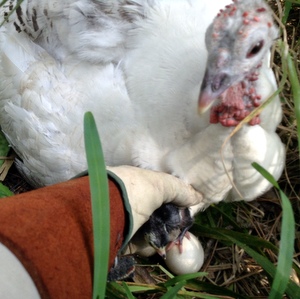
Note the arm guard!
Link to incubator/egg problems

Contact us at: Clovis636@AOL.com

My next book "Surviving Kennedy Space Center" available on Amazon, September 16, 2025
Peek behind the curtains of the space center

Lake 33 Killing Relic (navigates to my other web site)
Eastern Missouri, a little radioactive waste and a possible ghost, what could go wrong?
Do you need the perfect gift?
For pet lovers around the globe, "It's a Matter of Luck" is a collection of heart warming stories of horse rescues from the slaughterhouse.
Available on Amazon:
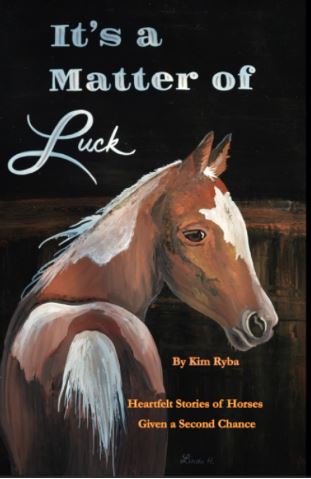
It's a Matter of Luck: Inspirational, Heartfelt Stories of Horses Given a Second Chance.
by Kim Ryba & Lina T. Lindgren
Warning: This book may cause your eyes to water -in a good way. (speaking from experience after reading it)
Please give Kim and Lina a heartfelt review on Amazon!

Author Bruce Ryba at Kennedy Space Center Launch Pad 39B & Artemis 1. "We are going to the Moon!"
Author's discussion (that's me) on You Tube of a book review on Amazon
My Facebook page Pet Turkeys You can always check in and say hello!
For the video versions of information, please check out my YouTube Channel (Turkeys, KSC, Flintknapping, dive stories etc.)
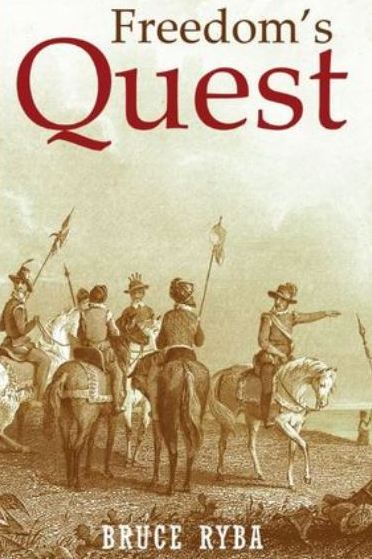
Book One of Florida History:
Freedoms Quest Struggle for the Northern Frontier and lost tales of old Florida
Fiction & language warning.
Available on Amazon

Desperate times call for bold action.
In a desperate move to retain Florida and protect the treasure-laden galleons on their dangerous return journey to Europe, the King of Spain issues a royal decree offering refuge to all English slaves who escape Florida and pick up a musket to defend the coquina walls of Saint Augustine.
In another bold gamble, the King offers refuge to the dissatisfied Indian nations of the southeast who will take up arms against the English.
Clans, traumatized by war and disease, cross the Spanish Frontier to settle the cattle-rich land and burned missions of Florida.
Follow the descendants of the conquistador Louis Castillo in remote Spanish Florida, a wildland swept by diseases, hurricanes, and northern invasions.
Book Two: Available on Amazon
